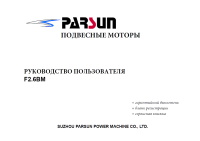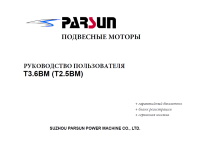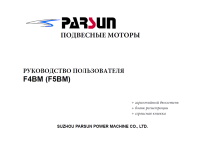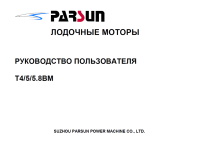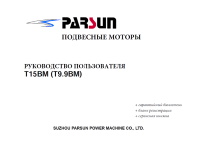Руководство по эксплуатации и техническому обслуживанию подвесного лодочного мотора Parsun F2.6BM.
- Год издания: —
- Страниц: 81
- Формат: PDF
- Размер: 4,1 Mb
Руководство по эксплуатации и техническому обслуживанию подвесных лодочных моторов Parsun T2.5BM и T3.6BM.
- Год издания: —
- Страниц: 67
- Формат: PDF
- Размер: 3,0 Mb
Руководство по эксплуатации и техническому обслуживанию подвесных лодочных моторов Parsun F4BM и F5BM.
- Год издания: —
- Страниц: 80
- Формат: PDF
- Размер: 4,6 Mb
Руководство по эксплуатации и техническому обслуживанию подвесных лодочных моторов Parsun T4BM, T5BM и T5.8BM.
- Год издания: —
- Страниц: 56
- Формат: PDF
- Размер: 1,6 Mb
Руководство по эксплуатации и техническому обслуживанию подвесных лодочных моторов Parsun F9.8BM и F15BM.
- Год издания: —
- Страниц: 78
- Формат: PDF
- Размер: 4,9 Mb
Руководство на английском языке по техническому обслуживанию и ремонту подвесных лодочных моторов Parsun F9.9BM/F9.9W/F15BM/F15W.
- Год издания: —
- Страниц: 106
- Формат: PDF
- Размер: 6,4 Mb
Руководство по эксплуатации и техническому обслуживанию подвесных лодочных моторов Parsun T9.9BM и T15BM.
- Год издания: —
- Страниц: 72
- Формат: PDF
- Размер: 3,3 Mb
Руководство по эксплуатации и техническому обслуживанию подвесных лодочных моторов Parsun T20BM, T25BM и T30BM.
- Год издания: —
- Страниц: 41
- Формат: PDF
- Размер: 797 Kb
Руководство по эксплуатации и техническому обслуживанию подвесных лодочных моторов Parsun T30BM/T30W/T35BM/T35W/T40BM/T40W.
- Год издания: —
- Страниц: 55
- Формат: DOC
- Размер: 1,6 Mb
Требуется руководство для вашей Parsun F9.9BM Лодочный подвесной мотор? Ниже вы можете просмотреть и загрузить бесплатно руководство в формате PDF. Кроме того, приведены часто задаваемые вопросы, рейтинг изделия и отзывы пользователей, что позволит оптимально использовать ваше изделие. Если это не то руководство, которое вы искали, – свяжитесь с нами.
Ваше устройство неисправно, и в руководстве отсутствует решение? Перейдите в Repair Café для получения бесплатных ремонтных услуг.
Руководство

Рейтинг
Сообщите нам, что вы думаете о Parsun F9.9BM Лодочный подвесной мотор, оставив оценку продукта. Хотите поделиться вашими впечатлениями от данного изделия или задать вопрос? Вы можете оставить комментарий в нижней части страницы.
Довольны ли вы данным изделием Parsun?
Да Нет
Будьте первым, кто оценит это изделие
0 голоса
Часто задаваемые вопросы
Наша служба поддержки выполняет поиск полезной информации по изделиям и отвечает на часто задаваемые вопросы. Если вы заметили неточность в наших часто задаваемых вопросах, сообщите нам об этом с помощью нашей контактной формы.
Каков рекомендуемый тип масла и интервал замены масла для моего подвесного мотора? Проверенный
Рекомендуемый тип масла и интервал замены для вашего подвесного мотора зависят от марки и модели вашего мотора. Важно обратиться к руководству пользователя или веб-сайту производителя для получения конкретных инструкций. Как правило, в 4-тактных подвесных моторах должно использоваться специальное судовое масло для 4-тактных двигателей, и рекомендуется менять его каждые 100 часов эксплуатации или ежегодно, в зависимости от того, что наступит раньше. В двухтактных подвесных моторах следует использовать масло с рейтингом TC-W3, и рекомендуется менять его каждые 50 часов использования или каждый сезон.
Это было полезно (12)
Как правильно обслуживать подвесной мотор? Проверенный
Надлежащее техническое обслуживание подвесного мотора включает в себя регулярную замену масла и фильтров, проверку и замену топливного фильтра, чистку или замену свечей зажигания и проверку уровня масла в редукторе. Также важно содержать систему охлаждения в чистоте, проверять гребной винт на наличие повреждений и поддерживать чистоту двигателя. Рекомендуется обратиться к руководству по эксплуатации вашего двигателя для получения конкретных инструкций и рекомендуемых интервалов обслуживания.
Это было полезно (9)
Как правильно подготовить подвесной мотор к зиме? Проверенный
Чтобы надлежащим образом подготовить подвесной мотор к зиме, вы должны сначала добавить стабилизатор топлива в бензобак и запустить двигатель на несколько минут, чтобы стабилизатор распространился по топливной системе. Затем замените масло и масляный фильтр и проверьте уровень смазки редуктора. Слейте воду из нижнего блока, удалив сливную пробку. Наконец, затуманьте двигатель аэрозольной смазкой и накройте двигатель, чтобы защитить его от непогоды.
Это было полезно (7)
Как правильно хранить подвесной мотор? Проверенный
Чтобы правильно хранить свой подвесной мотор, вы должны сначала убедиться, что он очищен и надлежащим образом подготовлен к зиме. Затем снимите пропеллер и храните его в сухом месте. Наконец, накройте двигатель и храните его в сухом защищенном месте, чтобы предотвратить повреждение от непогоды. Также рекомендуется хранить его на подставке для двигателя, чтобы масло не скапливалось на нижнем блоке.
Это было полезно (6)
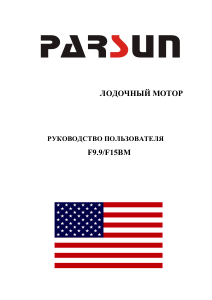
Parsun outboard motors are available for all boats, from PVC fishing boats to solid boats and yachts. Parsun is currently one of the fastest growing
manufacturers in the production of outboard motors.
Having appeared on the Chinese market in 2006, it used all the international experience gained in the production of outboard motors, using the most modern technologies and cheap skilled labor.
Taking as a model the best of the currently existing models of two-stroke and four-stroke outboard engines, Parsun manufactures a wide range of high-quality and
low-cost equipment.
Today, Parsun has 31 exclusive distributors in 39 countries. Quality and reasonable price ensures steady demand for Parsun outboard motors in European countries, for example, in
2008, more than 5,000 units were sold in Sweden alone.
-
Page 1
OUTBOARD MOTORS OWNER’S MANUAL F50/60 BWL-D F50/60 BWL-T F50/60 FWL-T SUZHOU PARSUN POWER MACHINE CO., LTD. -
Page 2
If there is any question concerning the manual, please consult your local PARSUN dealer. Data, illustrations or explanations in this Owner’s Manual do not constitute base for any legal claim against our company. -
Page 3
Engine Identification Numbers Outboard motor serial number The outboard motor serial number is marked on the label. The label can be found on the bracket left assembly or on the upper part of the bracket swivel. Record your outboard motor serial number in the spaces provided to assist you in ordering spare parts from your dealer or for reference in case your outboard motor is stolen. -
Page 4
Engine serial number The engine serial number is carved on the aluminum casting of engine. Engine serial number as follows:… -
Page 5: Table Of Contents
Table of contents 1. Main components and General information ………………1 1.1 Main components ……………………..1 1.2 General information ……………………. 5 1.2.1Specification ……………………..5 1.2.2 Fueling instruction ……………………6 1.2.3 Propeller selection ……………………7 2. Operation ……………………….8 2.1 Installation ……………………….8 2.1.1 Mounting height ……………………..
-
Page 6
2.11.1 Tilting up ……………………… 27 2.11.2 Tilting down ……………………..28 2.12 Cruising in other conditions ………………….29 2.12.1 Cruising in shallow water ………………….29 2.12.2 Cruising in salt water …………………… 30 3. Maintenance ………………………. 30 3.1 Greasing ……………………….31 3.2 Cleaning and adjusting spark plug ………………..32 3.3 Checking the fuel system …………………. -
Page 7
4.1 Transporting ……………………..46 4.2 Storing ……………………….47 4.3 Flusher ……………………….49 5. Actions in emergency ……………………50 5.1 Impact damage ……………………..50 5.2 Power trim and tilt unit will not operate ………………51 5.3 Starter will not operate ……………………52 5.4 Replacing fuse …………………….. -
Page 8: Main Components And General Information
1. Main components and General information 1.1 Main components 1.Top cowling 8. Tilt & trim rod 15. Throttle grip 2.Top cowling lock handle 9. Clamp bracket 16. Clam bolt 3.Drain screw 10.Tilt & trim button 17. Stand bar 4.Anti-cavitation plate 11.Tiller handle 18.
-
Page 9
A portable fuel tank includes parts as follows: 1. Fuel tank cap 3. Air vent screw 2. Fuel joint 4. Fuel gauge WARNING: The fuel tank supplier with this engine could only be used as supply of fuel for its running and … -
Page 10
Remote control lever Moving the lever forward from the neutral position engages forward gear. Pulling the lever back from neutral engages reverse. The engine will continue to run at idle until the lever is moved about 35º (a detent can be felt). Moving the lever farther opens the throttle, and the engine will begin to accelerate. Neutral “N”… -
Page 11
NOTE: The neutral throttle lever will operate only when the remote control lever is in neutral. The remote control lever will operate only when the neutral throttle lever is in the closed position. 1. Fully open 2. Fully closed… -
Page 12: General Information
1.2 General information 1.2.1Specification Main technical data: Items Data Items Data Type of engine Four cylinders,4-stroke Weight (BWL-T) 115Kg Displacement 996cm Weight (FWL-T) 110Kg Bore X stroke 65mm×75mm Recommended fuel Unleaded regular gasoline Gear ratio 1.85(24/13) Fuel tank capacity 1383mm(BWL-D/T) Overall length Recommended engine oil SAE10W30 or SAE10W40…
-
Page 13: Fueling Instruction
1.2.2 Fueling instruction Fueling instructions: Recommended gasoline: Regular unleaded gasoline,If it is not available, then premium gasoline. If knocking or pinging occurs, use a different brand of gasoline or premium unleaded fuel. If leaded gasoline is usually used, engine valves and related parts should be inspected after every 100 hours of operation.
-
Page 14: Propeller Selection
CAUTION: Use only new clean gasoline which has been stored in clean containers and is not contaminated with water or foreign matter. Engine oil: Recommended engine oil: 4-stroke outboard motor oil SAE10W30 and SAE10W40(1.7L). WARNING: Do not start the engine when the oil level is low. Serious damage might occur. …
-
Page 15: Operation
2. Operation 2.1 Installation Mount the outboard motor on the center line (keel line) of the boat. For boats without a keel or which are asymmetrical, consult your dealers. 1. Center line (keel line) NOTE: During water testing check the buoyancy of the boat, at rest, with its maximum load. Check that the static water level on the exhaust housing is low enough to prevent water entry into the power head, when water rises due to waves when the outboard is not running.
-
Page 16: Mounting Height
The optimum mounting height of the outboard motor is affected by the boat and motor combination and the desired use. Test runs at a different height can help determine the optimum mounting height. For further information, consult your “PARSUN” dealer or boat manufacturer.
-
Page 17: Clamping The Outboard Motor
2.1.2 Clamping the outboard motor 1. Tighten the transom clamp screw evenly and securely. Occasionally check the clamp screws for tightness during operation of the outboard motor because they could become loose due to engine vibration. CAUTION: Outboards that use clamp bracket screws alone are INSUFFICIENT to properly and safely secure the outboard to the Transom.
-
Page 18: Breaking In Engine
WARNING: Loose clamp screws could allow the outboard motor to fall off or move on the transom. This could cause loss of control. Make sure the clamp screws are tightened securely, occasionally check the screws for tightness during operation. 2.
-
Page 19: Pre-Operation Checks
1. for the first hour of operation: Run the engine at 2000 r/min or at approximately half throttle. 2. for the second hour of operation: Run the engine at3000 r/min or at approximately three-quarter throttle. 3. for the next eight hours of operation: Avoid continuous operation at full throttle for more than five minutes at a time.
-
Page 20
CAUTION ·Do not start the engine out of water. Overheating and serious engine damage can occur. ·Check the engine and engine mounting. ·Look for loose or damaged fasteners. ·Check the propeller for damage. Checking the engine oil level 1. Put the outboard motor in an upright position (not tilted). 2. -
Page 21: Filling Fuel
2.4 Filling fuel WARNING: Gasoline and its vapors are highly flammable and explosive. Keep away from sparks, cigarettes, flames, or other sources of ignition. 1. Remove the fuel tank cap. 2. Carefully fill the fuel tank. Securely close the cap after filling the tank. Wipe up any spilled fuel. 2.5 Starting engine 1.
-
Page 22
2. Connect fuel joints securely and squeeze the primer pump with the outlet end up until you feel it become firm (if equipped the fuel joint). 3. Place the gear shift lever in neutral. NOTE: The start-in-gear protection device prevents the engine from starting except when in neutral. Attach the engine stop switch lanyard to secure place on your clothing, or your arm or leg. -
Page 23
WARNING: The engine must be starting in neutral otherwise damage starter and hazard can occur. Do not attach the lanyard to clothing that could tear loose. Do not route the lanyard where it could become entangled and preventing it from functioning … -
Page 24
NOTE: It is not necessary to use the choke when starting a warm engine. If the choke is left in the “START” (start) position while the engine is running, the engine will run poorly or stall. 5. Pull the manual starter handle slowly until you feel resistance. Then give a strong pull straight to crank and start the engine. -
Page 25: Warm Up Engine
CAUTION · When the engine is cold, it needs to be warmed up. · If the engine does not start on the first try, repeat the procedure. If the engine fails to start after 4 or 5 tries: BW Models: open the throttle a small amount (between 1/8 and 1/4), and try again. FW models: open the neutral throttle lever on the remote control box, and try again.
-
Page 26: Shifting
2. Ensure the engine oil pressure warning lamp is off. WARNING: If the lamp keeps flashing after starting the engine, stop the engine immediately and check the engine oil level. Please fill the engine oil if necessary. If the problem cannot be corrected, consult your dealer.
-
Page 27: Forward
CAUTION: To shift from forward to reverse or vice versa, first close the throttle so that the engine idles (or runs at low speeds). 2.7.1 Forward 1. Place the throttle grip in the fully closed position. 2. Move the gear shift lever quickly and firmly from neutral to forward. Pull up the neutral interlock rigger and move the remote control lever quickly and firmly from neutral to forward.
-
Page 28: Reverse
2.7.2 Reverse WARNING: When operating in reverse, go slowly. Do not open the throttle more than half. Otherwise the boat could become unstable, which could result in loss of control and an accident. 1. Place the throttle trip in the fully closed position. 2.
-
Page 29: Tiller
2.8 Tiller 1. Change direction To change direction, move the tiller handle to the left or right as necessary. FW model: to clockwise or counterclockwise the steering wheel as necessary. 2. Change speed Turn the grip counterclockwise to increase speed and clockwise to decrease speed. FW model: Move the remote control lever to full open position to increase speed;…
-
Page 30
1. Throttle indicator 4. Throttle friction adjuster The throttle friction adjuster is on the tiller handle, which provides adjustable resistance to movement of the throttle grip, and can be set according to operator preference. To increase resistance, turn the adjuster clockwise. To decrease resistance, turn the adjuster counterclockwise. When constant speed is desired, tighten the adjuster to maintain the desired throttle setting. -
Page 31: Trim Tab
2.9 Trim tab The trim tab should be adjusted so that the steering control can turned to either the right or left by applying same amount of force. WARNING: An improperly adjusted trim tab could cause difficult steering. Always test run after the trim tab has been installed or replaced to be sure steering is correct.
-
Page 32: Trimming Outboard Motor
NOTE: If the outboard motor is equipped with an engine stop switch lanyard, the engine can also be stopped by pulling the lanyard and removing the lock plate from the engine stop switch. 2. Tighten the air vent screw on the fuel tank cap. 3.
-
Page 33
2. Remove the trim rod from the clamp bracket while slightly tilting the outboard motor up. 3. Reposition the rod in the desired hole. Make test runs with the trim set to different angles to find the position that works best for your boat and operating conditions. WARNING:… -
Page 34: Tilting Up
NOTE: Do not tilt up the engine by pushing the tiller handle because this could break the handle. The outboard motor cannot be tilted when in reverse. 2.11.1 Tilting up 1. Place the gear shift lever in neutral. Place the tilt lock lever (if equipped) in the up position.
-
Page 35: Tilting Down
3. Hold the rear handle and tilt the engine up fully until the tilt support lever automatically locks. For electric tilt model: Press the “UP” switch to tilt the outboard motor up to the highest position, and push in the tilt support lever.
-
Page 36: Cruising In Other Conditions
3. Pull down the tilt lock lever when outboard moves down to the lowest position. (For manual tilt model) WARNING: Make sure the tilt & trim unit is in locked position when running the outboard (For manual tilt model). 2.12 Cruising in other conditions 2.12.1 Cruising in shallow water The outboard motor can be tilted up partially to allow operation in shallow water.
-
Page 37: Cruising In Salt Water
CAUTION: The cooling water inlet on the lower unit should be not above the surface of the water when setting up for and cruising in shallow water. Otherwise severe damage from overheating can result. For tilting procedure, see section 2.11. 2.12.2 Cruising in salt water After operating in salt water, wash out the cooling water passages with fresh water to prevent them from becoming clogged with salt deposits.
-
Page 38: Greasing
3.1 Greasing…
-
Page 39: Cleaning And Adjusting Spark Plug
3.2 Cleaning and adjusting spark plug You should periodically remove and inspect the spark plug because heat and deposits will cause the spark plug to slowly break down and erode. If necessary, you should replace the spark plug with another of the correct type. Before fitting the spark plug, measure the electrode gap with a wire thickness gauge;…
-
Page 40: Checking The Fuel System
3.3 Checking the fuel system 1. Check the fuel lines for leaks, crack, or malfunction. If a problem is found, your dealer or other qualified mechanic should repair it immediately. WARNING: Check for fuel leakage regularly. If any fuel leakage is found, the fuel system must be repaired by a qualified mechanic. 2.
-
Page 41: Cleaning The Fuel Filter
3.3.1 Cleaning the fuel filter 1. Remove the nut holding the fuel filter assembly if equipped. 2. Unscrew the filter cup, catching any spilled fuel in a rag. 3 . Remove the filter element, and wash it in solvent. Allow it to dry. Inspect the filter element and O-ring of the filter cup to make sure they are in good conditions.
-
Page 42: Inspecting Idling Speed
4. Reinstall the filter element in the cup. Make sure the O-ring is in position in the cup. Firmly screw the cup onto the filter housing. 5. Attach the filter assembly to the bracket so that the fuel hoses are attached to the filter assembly. Run the engine and check the filter and lines for leaks.
-
Page 43: Changing Engine Oil
3.5 Changing engine oil WARNING: Avoid draining the engine oil immediately after stopping the engine. The oil is hot and should be handled with care to avoid burns. Be sure the outboard motor is securely fastened to the transom or a stable stand. CAUTION: Change the engine oil after the first 10 hours of operation, and every 100 hours or at 6-month intervals thereafter.
-
Page 44
Prepare a suitable container that holds a larger amount than the engine oil capacity. Loosen and remove the drain screw while holding the container under the drain hole. Then remove the oil filler cap. Let oil drain completely. Wipe up any spilled oil immediately. 3. -
Page 45: Checking Wiring And Connectors
3.6 Checking wiring and connectors Check that each grounding wire is properly secured and each connector is engaged securely. 3.7 Checking for leakage Check that no exhaust or water leaks from the joints between the exhaust cover, cylinder head and body cylinder.
-
Page 46: Removing The Propeller
1. Check each of the propeller blades for wear, erosion from cavitation or ventilation, or other damage. 2. Check the propeller shaft for damage. 3. Check the splines’ shear pin for wear or damage. 4. Check for fish line tangled around the propeller shaft. 5.
-
Page 47: Installing The Propeller
1. Cotter pin 2.Nut 3.Washer 4.Propeller 5.Thrust washer 3.8.2 Installing the propeller CAUTION: Be sure to install the thrust washer before instating the propeller, otherwise the lower case and propeller boss could be damaged. Be sure to use a new cotter pin and bend the ends over securely. Otherwise the propeller could come off during operation and be lost.
-
Page 48: Changing Gear Oil
3.9 Changing gear oil WARNING: Be sure the outboard motor is securely fastened to the transom or a stable stand. Never get under the lower unit while the outboard motor is tilted, even when the tilt support lever or knob is locked. Serious injury could occur if the motor falls. 1.
-
Page 49: Cleaning Fuel Tank
Inspect the used oil after it has been drained. If the oil is milky, water is getting into the gear case which can cause gear damage. Consult your dealer. 5. Use a flexible or pressurized filling device; inject the gear oil into the gear oil drain screw hole. (430cm )…
-
Page 50: Checking And Replacing Anode(S)
5. Replace the gasket with a new one. Reinstall the fuel joint assembly and tighten the screws firmly. 3.11 Checking and replacing anode(s) Inspect the external anodes periodically. Remove scales from the surfaces of the anodes. Consult your dealer for replacement of external anodes. CAUTION: Do not paint anodes, as this would render them ineffective and can…
-
Page 51: Maintenance Table
3.13 Maintenance Table When utilized under normal condition, maintained and repaired in the proper manner, the motor can work normally within the normal life period. The normal life of the engine is 350 hours or 10 years, whichever occurs first. Frequency of maintenance operations may be adjusted according to the operating conditions, but the following table gives general guidelines.
-
Page 52
Continuation /…1 Initial Every Item Operations 10 hours 50 hours 100 hours 200 hours ( 1 month ) ( 3 months ) ( 6 months ) ( 1 year ) ○ Shift link/shift cable Check/adjustment ○ Thermostat Check Throttle link/throttle ○… -
Page 53: Transporting And Storing
4 Transporting and storing 4.1 Transporting The outboard motor should be trailed and stored in the normal running position. If there is insufficient road clearance in this position, then trailer the outboard motor in the tilt position using a motor support device.
-
Page 54: Storing
4.2 Storing When store your outboard motor for prolonged periods of time (2 months or longer), several important procedures must be performed to prevent excessive damage. It is advisable to have your outboard motor serviced by an authorized dealer prior to storage. However, you, the owner, with a minimum of tools, can perform the following procedures.
-
Page 55
6. Start the engine. Flush the cooling system. Perform the flushing and fogging at the same time, as fogging/lubricating of the engine is mandatory to prevent engine rust. 1. Lowest water level 2. Water surface CAUTION: If the fresh water level is below the level of the anti-cavitation plate, or if the water supply is insufficient, engine seizure may occur. -
Page 56: Flusher
outboard motor body. CAUTION: Store the fuel tank in a dry, well-ventilated place, not in direct sunlight. 4.3 Flusher Perform this procedure right after operation for thorough flushing. CAUTION: Do not perform this procedure while the engine is running. The water pump may be damaged from overheat, or serious damage can occur 1.
-
Page 57: Actions In Emergency
tap. 3. Flush the fresh water through the cooling passage for about 15 minutes. Turn off the water and remove the water pipe connector. 4. Install the water pipe connector onto the water pipe plug after flushing. Tighten the nut. WARNING:…
-
Page 58: Power Trim And Tilt Unit Will Not Operate
5.2 Power trim and tilt unit will not operate If the engine can not be tilted up or down with the power trim and tilt because of a discharged battery or a failure with the power trim and tilt unit, the engine can not be tilted manually. 1.
-
Page 59: Starter Will Not Operate
5.3 Starter will not operate If the starter mechanism does not operate, the engine can be started with an emergency starter rope. WARNING: Use this procedure only in an emergency and only to return to port for repairs. When the emergency starter rope is used to start the engine, the start-in-gear protection …
-
Page 60
1.Start-in-gear protection cable 3. Remove the starter cover after removing the three bolts. Disconnect the leads for the warning indicator 4. Prepare the engine for starting. For further information, see section 2.5. 5. Insert the knotted end of the emergency starter rope into the notch in the flywheel rotor and wind the rope several turns around the flywheel clockwise. -
Page 61: Replacing Fuse
7. Give a strong pull straight out to crank and start the engine. Repeat it necessary. 5.4 Replacing fuse If the fuse is burnt, select the correct ampere fuse to replace it from the accessory bag. WARNING: Make sure to use the correct fuse. The electric system will damage or fire could be caused if using the wrong fuse.
-
Page 62: Treatment Of Submerged Motor
5. Feed engine fogging oil or engine oil through the carburetor(s) and spark plug holes while starting the engine. 6. Take the outboard motor to a PARSUN dealer as soon as possible. CAUTION: Do not attempt to run the outboard motor until it has been completely inspected.
-
Page 63: Troubleshooting
6. Troubleshooting Trouble type Possible reason Recovery action Starter components are faulty Have serviced by your dealer Starter will not operate Shift level is not in neutral Shift to neutral Fuel tank is empty Fill tank with clean, fresh fuel Fuel is contaminated or stale Fill tank with clean, fresh fuel Clean or replace with recommended…
-
Page 64
Continuation /…1 Trouble type Possible reason Recovery action Check for pinched or kinked fuel line or Fuel system is obstructed other obstructions in fuel system Fuel is contaminated or stale Fill tank with clean, fresh fuel Clean or replace with recommended Fuel filter clogged type Spark plug gap is incorrect… -
Page 65
Continuation /…2 Trouble type Possible reason Recovery action Propeller is damaged Repair or replace propeller Adjust trim angle to achieve most efficient Trim angle is incorrect operation Motor is mounted at incorrect transom Adjust motor to proper transom height height Boat bottom is fouled with marine growth Clean boat bottom Weeds or other foreign matter are tangled… -
Page 66
Continuation /…3 Trouble type Possible reason Recovery action Thermostat is faulty or clogged Have serviced by your dealer Air vent screw on fuel tank is closed Open air vent screw Fuel pump has malfunctioned Have serviced by your dealer Engine power loss Fuel joint connection is incorrect Connect correctly Check and replace spark plug(s) as… -
Page 67: Circuit Diagram
7. Circuit diagram…
-
Page 69
Remote control box…
Посмотреть инструкция для Parsun F60 FEL-T бесплатно. Руководство относится к категории подвесные лодочные моторы, 1 человек(а) дали ему среднюю оценку 7.5. Руководство доступно на следующих языках: английский. У вас есть вопрос о Parsun F60 FEL-T или вам нужна помощь? Задайте свой вопрос здесь
Не можете найти ответ на свой вопрос в руководстве? Вы можете найти ответ на свой вопрос ниже, в разделе часто задаваемых вопросов о Parsun F60 FEL-T.
В чем разница между топливом E10 и E5?
Инструкция Parsun F60 FEL-T доступно в русский?
Не нашли свой вопрос? Задайте свой вопрос здесь

